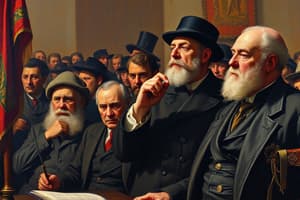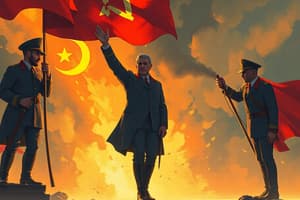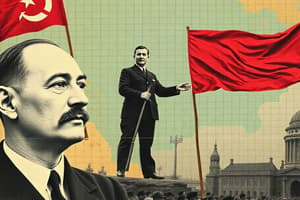Podcast
Questions and Answers
What was the primary goal of Lenin's one-party rule?
What was the primary goal of Lenin's one-party rule?
- To encourage democratic elections
- To create a capitalist economy
- To promote multiple political parties
- To consolidate Bolshevik power (correct)
The New Economic Policy (NEP) was introduced before War Communism.
The New Economic Policy (NEP) was introduced before War Communism.
False (B)
What organization did Lenin establish to suppress counter-revolutionaries?
What organization did Lenin establish to suppress counter-revolutionaries?
Cheka
Under War Communism, Lenin implemented _______ of all industries.
Under War Communism, Lenin implemented _______ of all industries.
What was a major consequence of War Communism on the economy?
What was a major consequence of War Communism on the economy?
Match the following policies to their descriptions:
Match the following policies to their descriptions:
Lenin's economic policies aimed to dismantle capitalist structures.
Lenin's economic policies aimed to dismantle capitalist structures.
What did Lenin's policy of Democratic Centralism involve?
What did Lenin's policy of Democratic Centralism involve?
What was the main purpose of the NEP?
What was the main purpose of the NEP?
Lenin's government was supportive of religious institutions.
Lenin's government was supportive of religious institutions.
What was one of the key social policies introduced by Lenin regarding women's rights?
What was one of the key social policies introduced by Lenin regarding women's rights?
The NEP allowed peasants to sell their surplus produce after meeting state ______.
The NEP allowed peasants to sell their surplus produce after meeting state ______.
Match the following aspects of Lenin's policies with their descriptions:
Match the following aspects of Lenin's policies with their descriptions:
Which statement accurately describes Lenin's approach to education?
Which statement accurately describes Lenin's approach to education?
Lenin's policies were controversial within the Communist Party.
Lenin's policies were controversial within the Communist Party.
What is one legacy of Lenin's policies in terms of governance?
What is one legacy of Lenin's policies in terms of governance?
Flashcards
Lenin's Political Policies
Lenin's Political Policies
Lenin's policies focused on consolidating Bolshevik power and establishing a one-party state in Russia, suppressing opposing political parties.
One-Party Rule
One-Party Rule
The Bolsheviks established a system of governance in which only their party held political power, suppressing other political groups.
Cheka
Cheka
The Bolshevik secret police, created by Lenin, used to suppress counter-revolutionaries through arrests, executions, and labor camps.
War Communism
War Communism
Signup and view all the flashcards
Nationalization
Nationalization
Signup and view all the flashcards
Democratic Centralism
Democratic Centralism
Signup and view all the flashcards
Lenin's Economic Policies
Lenin's Economic Policies
Signup and view all the flashcards
New Economic Policy (NEP)
New Economic Policy (NEP)
Signup and view all the flashcards
War Communism's Impact
War Communism's Impact
Signup and view all the flashcards
NEP
NEP
Signup and view all the flashcards
Market Reforms (NEP)
Market Reforms (NEP)
Signup and view all the flashcards
Mixed Economy (NEP)
Mixed Economy (NEP)
Signup and view all the flashcards
"Commanding Heights" Doctrine
"Commanding Heights" Doctrine
Signup and view all the flashcards
Soviet Education Policy
Soviet Education Policy
Signup and view all the flashcards
Women's Rights in Soviet Union
Women's Rights in Soviet Union
Signup and view all the flashcards
Secularization
Secularization
Signup and view all the flashcards
NEP Economic Recovery
NEP Economic Recovery
Signup and view all the flashcards
Centralized, Authoritarian Soviet Governance
Centralized, Authoritarian Soviet Governance
Signup and view all the flashcards
Stalin's Policies
Stalin's Policies
Signup and view all the flashcards
Study Notes
Lenin's Policies (1917-1924)
-
Political Policies:
- One-Party Rule: Bolsheviks established a one-party state, suppressing other parties (like Mensheviks and Socialist Revolutionaries).
- Repressive Measures: Cheka (secret police) used arrests, executions, and labor camps to enforce Bolshevik control.
- War Communism (1918-1921): Implemented during the Russian Civil War, this policy involved nationalizing industries, confiscating grain, and forcing labor to support the Red Army.
- Democratic Centralism: Promoted internal party debate, but subsequent decisions required unified party adherence.
-
Economic Policies:
- Nationalization & State Control: Lenin aimed to transition away from capitalism by nationalizing key industries and restricting private trade.
- War Communism's Economic Strain: Extreme centralization, requisitioning, and civil war led to widespread economic hardship, decreased production, rising inflation, and peasant resistance.
- New Economic Policy (NEP, 1921-1928): Introduced to revive the economy after the devastation of War Communism:
- Allowed limited private trade and small businesses, especially in agriculture and retail.
- Peasants could sell surplus produce after meeting quotas.
- A mixed economy emerged, with state control over key industries combined with market-based elements in others.
- NEP revived the economy through increased food production and reduced famine.
- "Commanding Heights" Doctrine: State control over critical sectors of the economy (heavy industry, banking, foreign trade) while allowing market flexibility elsewhere.
-
Social Policies and Ideological Reforms:
- Education and Literacy: Prioritized education to create a socialist society, with literacy programs aiming for loyal Soviet citizens.
- Women's Rights: Promoted gender equality in areas like pay, divorce, and abortion rights. Also encouraged women's workforce participation.
- Secularization: A strongly anti-religious stance, emphasizing atheism and secular education, and seizing church lands to promote secularism.
-
Legacy and Impact:
- NEP's Economic Turnaround: Successful short-term economic recovery, but also controversial within the party due to its partial retreat from pure socialism.
- Authoritarian Centralization: Lenin’s policies laid the groundwork for the highly centralized, authoritarian governance of the Soviet Union under Stalin.
- Foundation for Stalin's Policies: Many of Lenin's policies, including state control, one-party rule, and suppression of dissent, were expanded upon and utilized by Stalin.
Studying That Suits You
Use AI to generate personalized quizzes and flashcards to suit your learning preferences.




